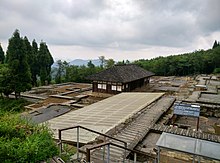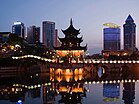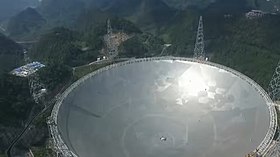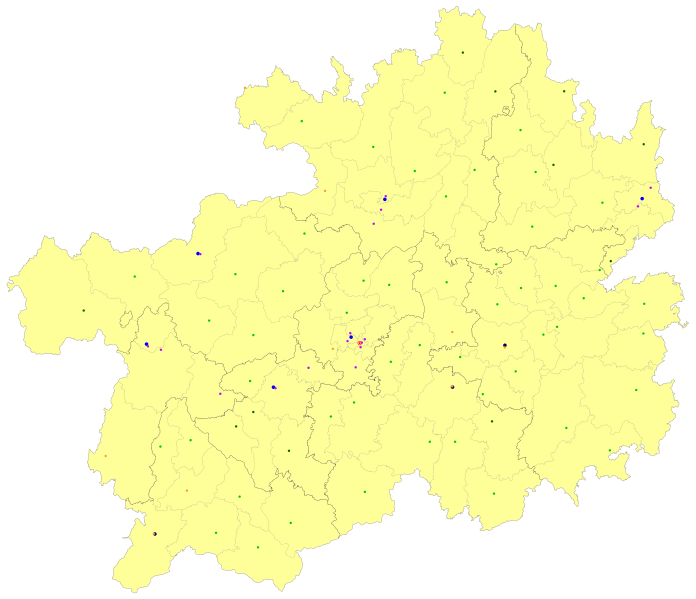
A | B | C | D | E | F | G | H | CH | I | J | K | L | M | N | O | P | Q | R | S | T | U | V | W | X | Y | Z | 0 | 1 | 2 | 3 | 4 | 5 | 6 | 7 | 8 | 9
Guizhou
贵州 | |
|---|---|
| Province of Guizhou | |
| Name transcription(s) | |
| • Chinese | 贵州省 (Guìzhōu Shěng) |
| • Abbreviation | GZ / 黔 or 贵 (pinyin: Qián or Guì) |
(clockwise from top)
| |
 Map showing the location of Guizhou Province | |
| Coordinates: 26°50′N 106°50′E / 26.833°N 106.833°E | |
| Country | China |
| Named for | Gui - Gui Mountains zhou (prefecture) |
| Capital | Guiyang |
| Largest city | Zunyi |
| Divisions | 9 prefectures, 88 counties, 1539 townships |
| Government | |
| • Type | Province |
| • Body | Guizhou Provincial People's Congress |
| • CPC Secretary | Xu Lin |
| • Congress chairman | Xu Lin |
| • Governor | Li Bingjun |
| • CPPCC chairman | Zhao Yongqing |
| Area | |
| • Total | 176,167 km2 (68,018 sq mi) |
| • Rank | 16th |
| Highest elevation | 2,900 m (9,500 ft) |
| Population (2020)[2] | |
| • Total | 38,562,148 |
| • Rank | 17th |
| • Density | 220/km2 (570/sq mi) |
| • Rank | 18th |
| Demographics | |
| • Ethnic composition | Han - 62% Miao - 12% Buyei - 8% Dong - 5% Tujia - 4% Yi - 2% Undistinguished - 2% Gelao - 2% Sui - 1% |
| • Languages and dialects | Southwestern Mandarin |
| GDP[3] | |
| • Total | CN¥ 1.78 trillion US$ 258 billion |
| • Per capita | CN¥ 52,321 US$ 7,779 |
| ISO 3166 code | CN-GZ |
| HDI (2019) | medium · 30th |
| Website | http://www.gzgov.gov.cn (Simplified Chinese) |
| Guizhou | |||||||||||||||||||||||||||||||||
|---|---|---|---|---|---|---|---|---|---|---|---|---|---|---|---|---|---|---|---|---|---|---|---|---|---|---|---|---|---|---|---|---|---|
 "Guizhou" in Simplified (top) and Traditional (bottom) Chinese characters | |||||||||||||||||||||||||||||||||
| Chinese name | |||||||||||||||||||||||||||||||||
| Simplified Chinese | 贵州 | ||||||||||||||||||||||||||||||||
| Traditional Chinese | 貴州 | ||||||||||||||||||||||||||||||||
| Hanyu Pinyin | Guìzhōu | ||||||||||||||||||||||||||||||||
| Postal | Kweichow | ||||||||||||||||||||||||||||||||
| |||||||||||||||||||||||||||||||||
| Zhuang name | |||||||||||||||||||||||||||||||||
| Zhuang | Gveicouh 贵州 | ||||||||||||||||||||||||||||||||
| Yi name | |||||||||||||||||||||||||||||||||
| Yi | ꇭꍏ | ||||||||||||||||||||||||||||||||
Guizhou[a] is an inland province in Southwestern China. Its capital and largest city is Guiyang, in the center of the province. Guizhou borders the autonomous region of Guangxi to the south, Yunnan to the west, Sichuan to the northwest, the municipality of Chongqing to the north, and Hunan to the east. The Guizhou Province has a Humid subtropical climate. It covers a total area of 176,200 square kilometers and consists of 6 prefecture-level cities and 3 autonomous prefectures. The population of Guizhou stands at 38.5 million, ranking 18th among the provinces in China.
The Dian Kingdom, which inhabited the present-day area of Guizhou, was annexed by the Han dynasty in 106 BC.[6] Guizhou was formally made a province in 1413 during the Ming dynasty. After the overthrow of the Qing in 1911 and following the Chinese Civil War, the Chinese Communist Party took refuge in Guizhou during the Long March between 1934 and 1935.[7] After the establishment of the People's Republic of China, Mao Zedong promoted the relocation of heavy industry into inland provinces such as Guizhou, to better protect them from potential foreign attacks.[citation needed]
Located in the hinterland of the southwestern inland region, Guizhou is a transportation hub in the southwest area and an important part of the Yangtze River Economic Belt.[8] It is the country's first national-level comprehensive pilot zone for big data,[9] a world-renowned mountain tourism destination and a major mountain tourism province,[10] a national ecological civilization pilot zone,[11] and an inland open economic pilot zone. [12]
The representative historical culture is "Qian Gui culture"(黔贵文化).[13] In addition, Guizhou is also one of the birthplaces of ancient Chinese humans and ancient Chinese culture, with humans living and multiplying on this land about half a million to six hundred thousand years ago.[14]
Guizhou is rich in natural, cultural and environmental resources. Its natural industry includes timber and forestry, and the energy and mining industries constitute an important part of its economy. Notwithstanding, Guizhou is considered a relatively undeveloped province, with the fourth-lowest GDP per capita in China as of 2020. However, it is also one of China's fastest-growing economies.[15] The Chinese government is looking to develop Guizhou as a data hub.[16][17]
Guizhou is a mountainous province, with its higher altitudes in the west and centre. It lies at the eastern end of the Yungui Plateau. Demographically, it is one of China's most diverse provinces. Minority groups account for more than 37% of the population, including sizable populations of the Miao, Bouyei, Dong, Tujia and Yi peoples, all of whom speak languages distinct from Chinese. The main language spoken in Guizhou is Southwestern Mandarin, a variety of Mandarin.
Name
The area was first organized as an administrative region of a Chinese empire under the Tang, when it was named Juzhou (矩州), pronounced Kjú-jyuw in the Middle Chinese of the period.[18] During the Mongol-led Yuan dynasty, the character 矩 (ju, "carpenter's square") was changed to the more refined 貴 (gui, "precious or expensive").[18] The region formally became a province in 1413, with an eponymous capital then also called "Guizhou" but now known as Guiyang.[18]
History

Evidence of settlement by humans during the Middle Palaeolithic is indicated by stone artefacts, including Levallois pieces, found during archaeological excavations at Guanyindong Cave. These artefacts have been dated to approximately 170,000–80,000 years ago using optically stimulated luminescence methods.[19]
From around 1046 BC to the emergence of the State of Qin, northwest Guizhou was part of the State of Shu.[7] During the Warring States period, the Chinese state of Chu conquered the area, and control later passed to the Dian Kingdom. During the Chinese Han dynasty (206 BC–220 AD), to which the Dian was tributary, Guizhou was home to the Yelang collection of tribes, which largely governed themselves before the Han consolidated control in the southwest and established the Lingnan province.[7] During the Three Kingdoms period, parts of Guizhou were governed by the Shu Han state based in Sichuan, followed by Cao Wei (220–266) and the Jin dynasty (266–420).[7]
During the 8th and 9th centuries in the Tang dynasty, Chinese soldiers moved into Guizhou (Kweichow) and married native women. Their descendants are known as Lǎohànrén (老汉人), in contrast to new Chinese who populated Guizhou at later times. They still speak an archaic dialect.[20] Many immigrants to Guizhou were descended from these soldiers in garrisons who married these pre-Chinese women.[21]
Kublai Khan and Möngke Khan conquered the Chinese southwest in the process of defeating the Song during the Mongol invasion of China, and the newly established Yuan dynasty (1279–1368) saw the importation of Chinese Muslim administrators and settlers from Bukhara in Central Asia.[7]

It was during the following Ming dynasty, which was once again led by Han Chinese, that Guizhou was formally made a province in 1413. The Ming established many garrisons in Guizhou from which to pacify the Yao and Miao minorities during the Miao Rebellions.[7] Chinese-style agriculture flourished with the expertise of farmers from Sichuan, Hunan and its surrounding provinces into Guizhou. Wu Sangui was responsible for the ousting the Ming in Guizhou and Yunnan during the Manchu conquest of China. During the governorship-general of the Qing dynasty's nobleman Ortai, the tusi system of indirect governance of the southwest was abolished, prompting rebellions from disenfranchised chieftains and the further centralization of government. After the Second Opium War, criminal triads set up shop in Guangxi and Guizhou to sell British opium. For a time, Taiping Rebels took control of Guizhou, but they were ultimately suppressed by the Qing.[7] Concurrently, Han Chinese soldiers moved into the Taijiang region of Guizhou, married Miao women, and their children were brought up as Miao.[22][23]
More unsuccessful Miao rebellions occurred during the Qing, in 1735, from 1795–1806[24] and from 1854–1873.[25] After the overthrow of the Qing in 1911 and following Chinese Civil War, the Communists took refuge in Guizhou during the Long March (1934–1935).[7] While the province was formally ruled by the warlord Wang Jialie, the Zunyi Conference in Guizhou established Mao Zedong as the leader of the Communist Party. As the Second Sino-Japanese War pushed China's Nationalist Government to its southwest base of Chongqing, transportation infrastructure improved as Guizhou was linked with the Burma Road.[26] After the end of the War, a 1949 Revolution swept Mao into power, who promoted the relocation of heavy industry into inland provinces such as Guizhou, to better protect them from Soviet and American attacks. The 1957 influenza pandemic started in Guizhou and killed a million people around the world. After the Chinese economic reform began in 1978, geographical factors led Guizhou to become the poorest province in China, with a GDP growth average of 9 percent from 1978 to 1993.[26]
District Planning
Regional history
In the 26th year of the Republic of China (1937), Guizhou established 6 administrative supervision areas, each in charge of several counties. In the 30th year (1941), Guiyang City was established. By the 37th year (1948), Guizhou had 1 direct jurisdiction area, 6 administrative supervision areas, and 78 counties (cities) under its administration.
On November 15, 1949, the Second Field Army of the Chinese People's Liberation Army liberated Guiyang; on December 26, the People's Government of Guizhou[27] Province was established. In the early period after liberation, the province had 1 directly managed city, 8 special areas, and 1 special area city, totaling 79 counties.
In April 1956, the Guiyang, Zhenyuan, and Duyun special areas were abolished, and the Qiandongnan Miao and Dong Autonomous Prefecture and the Qiannan Buyi and Miao Autonomous Prefecture were established, with their administrative centers in Kaili (the Qiandongnan Miao and Dong Autonomous Prefecture was established in Zhenyuan on July 23 of the same year and later moved to Kaili in 1958). In 1956, two villages from Qijiang County(綦江县), Sichuan Province, were transferred to Xishui County(习水县), Guizhou Province.
In 1960, the Langdai County(朗岱县) in Anshun Special Area was abolished and Liuzhi City was established, which was later changed back to Liuzhi County.
In 1965, the city status of Duyun was restored, serving as the capital of the Qiannan Buyi and Miao Autonomous Prefecture.
In 1966, on the basis of Liuzhi County(六枝县) in the former Anshun Special Area, Shuicheng County(水城县) in the Bijie Special Area,and Pan County in the Xingyi Special Area, Liuzhi Industrial and Mining Area, Shuicheng Industrial and Mining Area, and Pan County Industrial and Mining Area were established.
In 1970, the Wanshan Special District was established, under the jurisdiction of Tongren Special Area. The Liuzhi, Pan County, and Shuicheng industrial and mining areas and their original counties were merged into Liuzhi Special District, Pan County Special District, and Shuicheng Special Distric
In December 1978, the Liupanshui Special Area was abolished and the prefecture-level city of Liupanshui was established, governing three special districts, with the municipal government located in Shuicheng Special District, becoming the second prefecture-level city in Guizhou Province.
In September 1981, the Xingyi Special Area was abolished and the Qiannan Buyi and Miao Autonomous Prefecture was established, with its administrative center in Xingyi.
In 1983, Kaili County in the Qiandongnan Miao and Dong Autonomous Prefecture was abolished and the county-level Kaili City was established, serving as the capital of the autonomous prefecture.
In 1987, the Shuicheng Special District in Liupanshui City was abolished and Shuicheng County and Zhongshan District were established, with the Liupanshui municipal government moving to Zhongshan District; on August 21, Tongren County was abolished and Tongren City was established; on November 6, with the approval of the State Council, Xingyi County was abolished and Xingyi City was established.
In 1990, Chishui County in the Zunyi Special Area was abolished and the county-level Chishui City was established. Anshun City and Anshun County were merged to serve as the administrative center of Anshun Special Area.
In 1992, the Pan County Special District in Liupanshui City was abolished and Pan County was established. Qingzhen County in the Anshun Special Area was abolished and the county-level Qingzhen City was established, still under the jurisdiction of Anshun Special Area.
In 1994, Renhuai County in the Zunyi Special Area was abolished and the county-level Renhuai City was established. Bijie County in the Bijie Special Area was abolished and the county-level Bijie City was established, serving as the administrative center of Bijie Special Area.
In 1996, Qingzhen City, Xiuwen County, Kaiyang County, and Xifeng County, originally belonging to the Anshun Special Area, were transferred to the jurisdiction of Guiyang City.
In 1997, the Zunyi Special Area was abolished and the prefecture-level city of Zunyi was established, with the original county-level Zunyi City being changed to Honghuagang District. In 2000, the Anshun Special Area was abolished and the prefecture-level city of Anshun was established, with the original county-level Anshun City being changed to Xixiu District.
In 2003, parts of the Honghuagang District in Zunyi City were divided to establish the Huichuan District of Zunyi City.
In 2011, the Tongren Special Area was abolished and the prefecture-level city of Tongren was established, with the original county-level Tongren City being changed to Bijiang District, and the original Wanshan Special District being changed to Wanshan District. Tongren City governs 2 districts and 8 counties. In the same year, the Bijie Special Area was abolished and the prefecture-level city of Bijie was established. The original county-level Bijie City was changed to Qixingguan District.
In 2013, a pilot model of provincial direct management of counties was implemented, with the county-level Renhuai City, originally belonging to Zunyi City, and Weining County, originally belonging to Bijie City, being designated as pilot counties for provincial direct management.
On January 6, 2014, the State Council agreed to establish the Guizhou Gui'an New District.[28] In the same year, Pingba County in Anshun City was abolished and Pingba District of Anshun City was established.
In 2016, Zunyi County in Zunyi City was abolished and the district-level Bozhou District was established.
In April 2017, the Ministry of Civil Affairs agreed to abolish Pan County in Liupanshui City and establish the county-level Panzhou City, managed by Liupanshui City.
In August 2018, with the approval of the State Council, Xingren County in the Qiannan Buyi and Miao Autonomous Prefecture was abolished and the county-level Xingren City was established.
In July 2020, Shuicheng County in Liupanshui City was abolished and the district-level Shuicheng District was established.
In March 2021, with the approval of the State Council, the Ministry of Civil Affairs agreed to abolish Qianxi County and establish the county-level Qianxi City.
Geography

topography and landforms
Guizhou Province is located on the Yunnan-Guizhou Plateau, between longitudes 103°36′ to 109°35′ east and latitudes 24°37′ to 29°13′ north. The average altitude is around 1100 meters. It borders Hunan to the east, Guangxi to the south, Yunnan to the west, and Sichuan and Chongqing to the north. It stretches approximately 595 kilometers from east to west and about 509 kilometers from north to south. The total area of Guizhou Province is 176,167 square kilometers, accounting for 1.8% of the total area of China. The easternmost point is in Di Lake Township, Tianzhu County, Qiandongnan Prefecture. The westernmost point is in Yulong Township(玉龙乡), Weining County, Bijie City. The southernmost point is in Luowan Township(洛万乡), Xingyi City, Qianxinan Prefecture. The northernmost point is in Yangxi Town(阳溪镇), Daozhen County, Zunyi City.
Guizhou is a mountainous province, although its higher altitudes are in the west and centre. It lies at the eastern end of the Yungui Plateau.[29] At 2,900 m (9,514 ft) above sea level, Jiucaiping is Guizhou's highest point.[30]
Guizhou Plateau is predominantly mountainous, and its topography can be generally divided into three basic types: plateau mountains, hills, and basins(盆地), with 92.5% of the area being mountains and hills. There are numerous mountain ranges within the province, with overlapping ridges and peaks stretching across the landscape. In the north, there is the Dalou Mountain, which runs diagonally from the west to the northeast, with the important pass Loushan Pass at an altitude of 1444 meters; in the central and southern part, Miaoling Mountain(苗岭) [31]Range stretches across, with its main peak, Leigong Mountain(雷公山),[32] at 2178 meters; in the northeastern part, there is the Wuling Mountain Range, which winds into Guizhou from Hunan, with its main peak, Fanjing Mountain, at 2572 meters; in the west, there is the towering Wumeng Mountain(乌蒙山),[33] with the highest point in Guizhou being Jiucaiping(韭菜坪) in Zhushi Township(珠市乡), Hezhang County, at an altitude of 2900.6 meters.
climate
Guizhou has a humid subtropical climate. There are few seasonal changes. Its annual average temperature is roughly 10 to 20°C, with January temperatures ranging from 1 to 10°C and July temperatures ranging from 17 to 28°C. with annual rainfall ranging from 1000 to 1400 millimeters; the frost-free period lasts between 250 to 300 days. There is no severe cold in winter and no extreme heat in summer, with the coldest month of January averaging 4-6 degrees Celsius, and the hottest month of July averaging 15-23 degrees Celsius. The unique climatic characteristics make Guizhou an ideal place for leisure travel and summer retreats.[34] Precipitation is abundant, with a distinct rainy season, many cloudy days, and less sunshine, with the number of cloudy days generally exceeding 150 days throughout the year, and the annual relative humidity above 70%. Influenced by atmospheric circulation and terrain, Guizhou's climate is diverse, with the saying. Additionally, the climate is unstable, with a variety of disastrous weather conditions such as droughts, autumn winds, freezing, and hail, which can have a significant impact on agricultural production.
Like in China's other southwest provinces, rural areas of Guizhou suffered severe drought during spring 2010. Beginning on 3 April 2010, China's premier Wen Jiabao went on a three-day inspection tour in the southwest drought-affected province of Guizhou, where he met villagers and called on agricultural scientists to develop drought-resistant technologies for the area.[35]
Because of its lesser development compared to many other provinces in China, Guizhou's environment is well-preserved.[36]: 61 As of at least 2023, its environment and favorable climate have been assets in attracting the new, increasingly digital, economy.[36]: 61
hydrology
Guizhou Province's rivers are located in the upper reaches of the Yangtze River and Pearl River basins, with 69 counties falling within the scope of the Yangtze River protective forest conservation area,[37] making it an important ecological barrier for the upper reaches of both the Yangtze and Pearl Rivers. The water system of the province flows from the west and center towards the north, east, and south according to the terrain. Miao Ridge serves as the watershed between the Yangtze and Pearl River basins; to the north lies the Yangtze River basin, covering an area of 115,747 square kilometers, accounting for 65.7% of the province's total land area, with major rivers including: Wu River, Chishui River, Qingshuijiang, Hongzhou River(洪州河), Wuyang River, Jinjiang, Songtao River(松桃河), Songkan River(松坎河), Niulan River(牛栏江), Hengjiang(横江), etc.; to the south of Miao Ridge lies the Pearl River basin, covering an area of 60,420 square kilometers, accounting for 34.3% of the province's total land area, with major rivers including: Nanpan River, Beipan River, Hongshui River, Duliu River, Dagou River(打狗河), etc. Guizhou has a large number of rivers with continuous flow, and there are 984 rivers with a length of more than 10 kilometers.
Natural Resources
water resources
Guizhou Province has a large number of rivers, with 984 rivers that are over 10 kilometers long. In 2002, the runoff volume of Guizhou's rivers reached 114.52 billion cubic meters. [38]The mountainous characteristics of Guizhou's rivers are evident, with most rivers having broad valleys and gentle water flow in the upper reaches, with small water volume; the middle reaches have alternating tight and open valleys with rapid water flow; the lower reaches have deep and narrow valleys, with large water volume and abundant hydropower resources. The potential of hydropower resources is 18.745 million kilowatts, ranking sixth in China,[39] of which 16.833 million kilowatts are exploitable, accounting for 4.4% of China's total, with many concentrated river sections with large water level drops, and favorable development conditions.
land resources
Guizhou Province's land resources are predominantly mountainous and hilly, with relatively few plains. The mountainous area is 108,740 square kilometers, accounting for 61.7% of the total land area of Guizhou Province. The hilly area is 54,197 square kilometers, accounting for 31.1% of the total land area of Guizhou Province. The area of mountainous flatlands is 13,230 square kilometers, only accounting for 7.5% of the total land area of Guizhou Province.[40] There is a limited amount of land resources available for agricultural development. Due to the increasing population and the growth of non-agricultural land use, the area of arable land is continuously decreasing. By the end of 2002, the actual area of arable land in Guizhou Province was 1.7694 million hectares, a reduction of 62,900 hectares compared to 2001. The per capita area of arable land is less than 0.05 hectares, which is significantly lower than the national average of China. The proportion of arable land with thick soil layers, high fertility, and good water conditions is low.[41]
biological resources

The border mountains of Guizhou, Guangxi, and Hunan have been identified as one of the eight plant diversity hotspots in China. Guizhou Province is home to 9,982 species of vascular plants (including subspecies and varieties, the same below),[42]The main ecosystem types include evergreen broad-leaved forest, coniferous and broad-leaved mixed forest, and montane elfin forest. more than 700 of which are edible, and over 2,000 that are used for greening, beautification, and for pollution resistance and environmental improvement. Plant species endemic to this region include Abies ziyuanensis, Cathaya argyrophylla, and Keteleeria pubescens,Davidia involucrata, Guizhou Cycas.[43] The province is also rich in wildlife resources, with 1,053 species of vertebrates, including 141 mammals, 509 birds, 104 reptiles, 74 amphibians, and 225 fish species.[44] In broad terms, the Yunnan–Guizhou Plateau is one of the vertebrate diversity hotspots of China. At the level of counties, Xingyi is one of nine Chinese vertebrate (excluding birds) diversity hotspots.[45] Animals only known from Guizhou include Leishan moustache toad, Kuankuoshui salamander, Shuicheng salamander, Guizhou salamander, and Zhijin warty newt. [citation needed]
Caohai Lake with its surroundings is a wetland that is an important overwintering site for many birds. It is a National Nature Reserve and an Important Bird Area identified by BirdLife International.[46] Guizhou is one of the four major medicinal material-producing areas in China. The province boasts 4,419 species of medicinal plants and 301 medicinal animals. [47]It is famous for its 50 "authentic medicinal materials" known both domestically and internationally. Over 350 types of Chinese medicinal resources have been developed and utilized, with Gastrodia elata, Eucommia ulmoides, Coptis chinensis, Evodia rutaecarpa, and Dendrobium being the five famous medicinal materials of Guizhou.
mineral resources
Guizhou Province is rich in mineral resources and is a major province for mineral resources. More than 110 types of minerals have been discovered, among which 76 types have identified reserves. [48]Several have proven reserves that rank at the forefront nationwide. Those ranking first include mercury, barite, fertilizer sandstone, metallurgical sandstone, decorative diabase, and brick and tile sandstone, etc. Those ranking second include phosphorus, bauxite, rare earths, etc.; those ranking third include magnesium, manganese, gallium, etc. In addition, coal, antimony, gold, pyrite, and other minerals hold significant positions in China. Coal reserves are substantial, with a complete range of coal types and excellent coal quality, with proven reserves at the end of 2002 being 49.227 billion tons; bauxite proven reserves are 424 million tons; phosphate rock reserves are 2.695 billion tons, accounting for over 40% of the national total; barite reserves account for one-third of the country's total; gold reserves rank twelfth in the nation, making it an emerging base for gold production in China.
Scientific research
Major scientific research facilities in Guizhou include:
- The Five-hundred-meter Aperture Spherical Telescope (FAST), the world's largest radio telescope
- The Institute of Geochemistry, Chinese Academy of Sciences
Politics
Administrative divisions
Guizhou is divided into nine prefecture-level divisions: six prefecture-level cities and three autonomous prefectures:
| Administrative divisions of Guizhou | ||||||||||||
|---|---|---|---|---|---|---|---|---|---|---|---|---|
| Division code[49] | Division | Area in km2[50] | Population 2010[51] | Seat | Divisions[52] | |||||||
| Districts* | Counties | Aut. counties | CL cities | |||||||||
| 520000 | Guizhou Province | 176,167.00 | 34,746,468 | Guiyang city | 17 | 51 | 11 | 9 | ||||
| 520100 | Guiyang city | 8,046.67 | 4,324,561 | Guanshanhu District | 6 | 3 | 1 | |||||
| 520200 | Liupanshui city | 9,965.37 | 2,851,180 | Zhongshan District | 3 | 1 | ||||||
| 520300 | Zunyi city | 30,780.73 | 6,127,009 | Huichuan District | 3 | 7 | 2 | 2 | ||||
| 520400 | Anshun city | 9,253.06 | 2,297,339 | Xixiu District | 2 | 1 | 3 | |||||
| 520500 | Bijie city | 26,844.45 | 6,536,370 | Qixingguan District | 1 | 6 | 1 | |||||
| 520600 | Tongren city | 18,006.41 | 3,092,365 | Bijiang District | 2 | 4 | 4 | |||||
| 522300 | Qianxinan Aut. Prefecture | 16,785.93 | 2,805,857 | Xingyi city | 6 | 2 | ||||||
| 522600 | Qiandongnan Aut. Prefecture | 30,278.06 | 3,480,626 | Kaili city | 15 | 1 | ||||||
| 522700 | Qiannan Aut. Prefecture | 26,191.78 | 3,231,161 | Duyun city | 9 | 1 | 2 | |||||
| * - including Special district | ||||||||||||
| Administrative divisions in Chinese and varieties of romanizations | ||||
|---|---|---|---|---|
| English | Chinese | Pinyin | ||
| Guizhou Province | 贵州省 | Guìzhōu Shěng | ||
| Guiyang city | 贵阳市 | Guìyáng Shì | ||
| Liupanshui city | 六盘水市 | Liùpánshuǐ Shì | ||
| Zunyi city | 遵义市 | Zūnyì Shì | ||
| Anshun city | 安顺市 | Ānshùn Shì | ||
| Bijie city | 毕节市 | Bìjié Shì | ||
| Tongren city | 铜仁市 | Tóngrén Shì | ||
| Qianxinan Aut. Prefecture | 黔西南自治州 | Qiánxīnán Zìzhìzhōu | ||
| Qiandongnan Aut. Prefecture | 黔东南自治州 | Qiándōngnán Zìzhìzhōu | ||
| Qiannan Aut. Prefecture | 黔南自治州 | Qiánnán Zìzhìzhōu | ||
These nine prefecture-level divisions are in turn subdivided into 88 county-level divisions (14 districts, 7 county-level cities, 55 counties, and 11 autonomous counties and one special district).
Urban areas
| Population by urban areas of prefecture & county cities | ||||
|---|---|---|---|---|
| # | Cities | 2020 Urban area[53] | 2010 Urban area[54] | 2020 City proper |
| 1 | Guiyang | 4,021,275 | 2,520,061 | 5,987,018 |
| 2 | Zunyi | 1,675,245 | 715,148[b] | 6,606,675 |
| 3 | Liupanshui | 818,753[c] | 491,438 | 3,031,602 |
| 4 | Bijie | 695,174 | 421,342[d] | 6,899,636 |
| 5 | Anshun | 685,654 | 358,920[e] | 2,470,630 |
| 6 | Xingyi | 649,497 | 335,243 | part of Qianxinan Prefecture |
| 7 | Kaili | 519,243 | 274,922 | part of Qiandongnan Prefecture |
| 8 | Tongren | 423,078 | 206,147[f] | 3,298,468 |
| 9 | Panzhou | 420,894 | [g] | see Liupanshui |
| 10 | Renhuai | 361,723 | 171,005 | see Zunyi |







